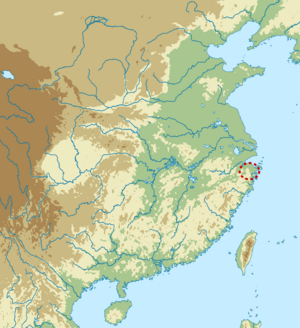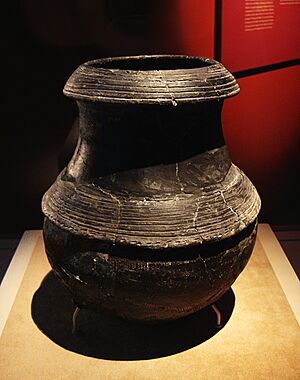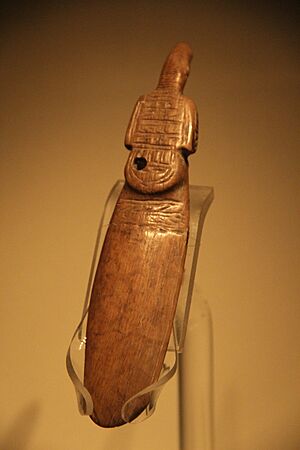Hemudu culture facts for kids
 |
|||||||
| Geographical range | Eastern China | ||||||
|---|---|---|---|---|---|---|---|
| Period | Neolithic China | ||||||
| Dates | c. 5500 – c. 3300 BC | ||||||
| Chinese name | |||||||
| Chinese | 河姆渡文化 | ||||||
|
|||||||
The Hemudu culture was an ancient group of people who lived in China during the Neolithic period, also known as the New Stone Age. They existed from about 5500 BC to 3300 BC. These people lived just south of the Hangzhou Bay in a region called Jiangnan. Today, this area is part of Yuyao, Zhejiang province in China.
The Hemudu culture can be divided into two main time periods: an early phase and a later phase, with the year 4000 BC as a dividing point. The main site where their remains were found is called Hemudu. It was discovered in 1973, about 22 kilometers (14 miles) northwest of Ningbo. Other Hemudu sites were also found at Tianluoshan in Yuyao and on the Zhoushan islands.
Contents
Daily Life and Homes
The Hemudu people lived at the same time as another ancient group, the Majiabang culture. They likely shared ideas and ways of life. At one point, big floods from the Yaojiang River made the soil too salty. This forced the Hemudu people to leave their homes.
The Hemudu people built their homes as long stilt houses. These houses were raised above the ground on poles. This style of building is similar to homes found in Borneo today. They also had large communal longhouses where many people could live together.
Farming and Food
The Hemudu culture was one of the first groups to grow rice. Digs at the Tianluoshan site show that rice was slowly changing into a domesticated crop. This means people were learning to grow it on purpose. Many tools found at Hemudu were made from animal bones. For example, they used hoes made from shoulder bones to help grow rice.
The Hemudu people grew many different plants. These included water caltrop, lotus (Nelumbo nucifera), acorns, melons, wild kiwifruit, blackberries, peaches, foxnuts (Gorgon euryale), and bottle gourds.
They likely raised pigs for food. However, they also hunted a lot of deer and some wild water buffalo. Fishing was very important too, especially catching crucian carp. We know this because archaeologists found bone harpoons and bows and arrowheads.
Crafts and Art
The Hemudu culture was known for making special items. They produced lacquer wood objects. A red lacquer wood bowl found at the Zhejiang Museum is very old, dating back to 4000-5000 BC. It is thought to be the oldest lacquer object ever found.
They made thick, porous pottery. This pottery was usually black and made by mixing charcoal powder into the clay. They often decorated their pottery with plant and geometric designs. Sometimes, the pottery had cord marks on it. The Hemudu people also created beautiful carved jade ornaments and carved ivory artifacts. They even made small clay figurines.
Society and Family Life
In the early days of the Hemudu culture, families were likely organized around the mother's side. This means that women and children had a high social standing. Later on, their society slowly changed to be organized around the father's side. During this time, men gained more social importance, and family lines were traced through the father.
Beliefs and Spirits
The Hemudu people had strong spiritual beliefs. They worshiped a sun spirit and a fertility spirit. They also performed special shamanistic rituals to honor the sun. They believed in bird totems, which are symbols of a spirit or animal that guides a group.
People also believed in an afterlife and in ghosts. When someone died, they were usually buried with their head facing east or northeast. Most burials did not include any special objects. Babies were buried in urns, while children and adults were buried directly in the ground. For a long time, they didn't have one main burial ground for everyone. However, a shared burial ground for a clan was found from the later period. This site suggests that two different clans who married each other used this burial ground. More burial goods were found in this communal area.
Environment and Climate
Studies of ancient plants and tiny organisms suggest that the Hemudu culture grew during a warm period. This was a time when sea levels might have been stable and lower. However, between 5000 and 3900 BC, there were often floods. The climate in the Hemudu region was warm, like a tropical or subtropical area. It had high temperatures and a lot of rain throughout the year.
See also
- List of Neolithic cultures of China
- Liangzhu culture
- Majiabang culture
- Yangshao culture




